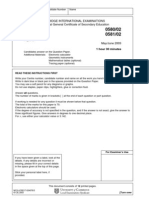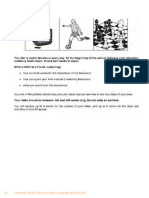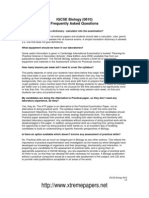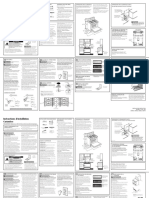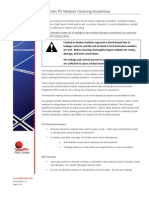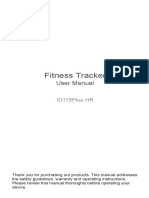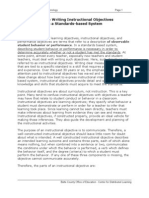0510 w17 Ms 21 PDF
0510 w17 Ms 21 PDF
Uploaded by
Mahmoud GomaaCopyright:
Available Formats
0510 w17 Ms 21 PDF
0510 w17 Ms 21 PDF
Uploaded by
Mahmoud GomaaOriginal Title
Copyright
Available Formats
Share this document
Did you find this document useful?
Is this content inappropriate?
Copyright:
Available Formats
0510 w17 Ms 21 PDF
0510 w17 Ms 21 PDF
Uploaded by
Mahmoud GomaaCopyright:
Available Formats
www.dynamicpapers.
com
Cambridge Assessment International Education
Cambridge International General Certificate of Secondary Education
ENGLISH AS A SECOND LANGUAGE 0510/21
Paper 2 Reading and Writing (Extended) October/November 2017
MARK SCHEME
Maximum Mark: 90
Published
This mark scheme is published as an aid to teachers and candidates, to indicate the requirements of the
examination. It shows the basis on which Examiners were instructed to award marks. It does not indicate the
details of the discussions that took place at an Examiners’ meeting before marking began, which would have
considered the acceptability of alternative answers.
Mark schemes should be read in conjunction with the question paper and the Principal Examiner Report for
Teachers.
Cambridge International will not enter into discussions about these mark schemes.
Cambridge International is publishing the mark schemes for the October/November 2017 series for most
®
Cambridge IGCSE , Cambridge International A and AS Level components and some Cambridge O Level
components.
® IGCSE is a registered trademark.
This document consists of 12 printed pages.
© UCLES 2017 [Turn over
0510/21 Cambridge IGCSE – Mark Scheme October/November
www.dynamicpapers.com
PUBLISHED 2017
IGCSE English as a Second Language Extended tier Reading/Writing (Paper 2)
This component forms part of the Extended tier assessment of IGCSE English as a Second Language
and tests the following Assessment Objectives:
AO1: Reading
R1 identify and retrieve facts and details
R2 understand and select relevant information
R3 recognise, understand ideas, opinions and attitudes and the connections between the related
ideas
R4 understand what is implied but not actually written, e.g. gist, relationships, writer’s
purpose/intention, writer’s feelings, situation or place
AO2: Writing
W1 communicate clearly, accurately and appropriately
W2 convey information and express opinions effectively
W3 employ and control a variety of grammatical structures
W4 demonstrate knowledge and understanding of a range of appropriate vocabulary
W5 observe conventions of paragraphing, punctuation and spelling
W6 employ appropriate register/style
Overview of exercises on Paper 2
Reading Marks for Writing Marks for Total
objectives reading objectives writing available
tested objectives tested objectives marks
Exercise 1 Reading (1) R1 9 – 9
Exercise 2 Reading (2) R1, R2, R4 15 – 15
Exercise 3 Information R1, R2, R4 6 W1, W5 2 8
transfer
Exercise 4 Note- R1, R2, R3 9 – 9
making
Exercise 5 Summary R1, R2, R3 6 W1, W2, 5 11
W3, W4,
W5
Exercise 6 Writing (1) – W1, W2, 19 19
W3, W4,
W5, W6
Exercise 7 Writing (2) – W1, W2, 19 19
W3, W4,
W5, W6
90
© UCLES 2017 Page 2 of 12
0510/21 Cambridge IGCSE – Mark Scheme October/November
www.dynamicpapers.com
PUBLISHED 2017
Exercise 1: Volunteering for archaeological work
Question Answer Marks
1(a) learn about past 1
1(b) raise awareness / public awareness 2
AND
speed (up project) / help
ONE MARK FOR EACH CORRECT DETAIL
1(c) universities 1
1(d) legal reasons 1
1(e) (level of) fitness / being ready physically 1
1(f) (start) early / start time 1
1(g) ‘tool talk’ (given) 1
1(h) pieces of pot(s) 1
© UCLES 2017 Page 3 of 12
0510/21 Cambridge IGCSE – Mark Scheme October/November
www.dynamicpapers.com
PUBLISHED 2017
Exercise 2: ‘The mountain ash tree’
Question Answer Marks
2(a) (perfect place to observe) wildlife 1
2(b) wet weather / when it rains / when weather changes 1
2(c) 99.6 metres / 99.6 meters / 99.6 m 1
2(d) grow wide(r) 1
2(e) grow less / smaller 2
AND
capture less energy / less energy from sun
ONE MARK FOR EACH CORRECT DETAIL
2(f) leaves (quite) large / size of leaves 1
2(g) humans / logging / (trees) cut down 1
2(h) protected (areas) / (state) regulations 1
2(i) falling prices / lower prices 2
AND
(pressure from) environmental organisations / environmental concerns
ONE MARK FOR EACH CORRECT DETAIL
2(j) 1 mountain ash not as tall / giant redwoods taller 4
mountain ash height limit / giant redwoods no height limit
2 mountain ash don’t live as long / giant redwoods live longer
mountain ash live 400 years / giant redwood live 3000 years
3 mountain ash have flowers / mountain ash tallest flowering trees /
giant redwoods no flowers
4 mountain ash die from fires / giant redwoods don’t die in fires
mountain ash don’t grow branches after fires / giant redwoods grow
branches after fires
5. mountain ash can’t resist diseases / giant redwoods resist diseases
(accept ‘ash’ and ‘redwood’ to refer to trees)
ONE MARK EACH FOR ANY FOUR FROM FIVE
© UCLES 2017 Page 4 of 12
0510/21 Cambridge IGCSE – Mark Scheme October/November
www.dynamicpapers.com
PUBLISHED 2017
Exercise 3: Video games tester
Question Answer Marks
3 Section A
Full name: Dominic Noles 9
Age: 16 (years (old)) / sixteen (years (old)) 9
Country of residence: Belgium 9
Email: dominogamer1@truemail.com 9
What interests do you have besides gaming? (playing) guitar 9
Section B
How long have you been playing video games? 8 years 9
Which type of games have you played most? TICK role-playing 9
What’s the name of your favourite video game? Questor 9
Why do you like this game so much? (set(s)) complicated challenges 9
Section C
Which of your personal qualities do you think would make you a good 9
video games tester?
logical (mind) OR (ability to) focus on detail(s) (only one required)
How did you first find out about this video games tester training? 9
(computer science) teacher
Which of the video games tester training programmes would you prefer 9
to do?
CIRCLE Programme C
Total for Sections A–C: 6
© UCLES 2017 Page 5 of 12
0510/21 Cambridge IGCSE – Mark Scheme October/November
www.dynamicpapers.com
PUBLISHED 2017
Question Answer Marks
3 Section D
Example of an acceptable sentence: 2
I would like to work as a video games designer because I want a well (-) paid
job.
Do not accept ‘tester’ for ‘designer’
Marking Criteria
2 marks: no fewer than 12 and no more than 20 words; proper sentence
construction; correct spelling, punctuation and grammar; relevant to context.
1 mark: no fewer than 12 and no more than 20 words; proper sentence
construction; 1–3 errors of punctuation / spelling / grammar that do not
obscure meaning; relevant to context.
0 marks: more than 3 errors of punctuation / spelling / grammar; and / or
irrelevant to context, and / or not a proper sentence; and / or fewer than 12
words or more than 20 words.
Absence of a full stop at the end should be considered as 1 punctuation
error.
Absence of an upper case letter at the beginning should be considered
as 1 punctuation error.
Omission of a word in the sentence should be considered as 1 grammar
error.
© UCLES 2017 Page 6 of 12
0510/21 Cambridge IGCSE – Mark Scheme October/November
www.dynamicpapers.com
PUBLISHED 2017
Exercise 4: Walking with lions: the lion encounter project
Question Answer Marks
4 The young lions – some physical facts Max 3
1 100 kg
2 agile / jump easily
3 40 kph / fast
Rules for visitors going on lion walks Max 3
4 accompanied
5 carry stick
6 stay behind (lions)
7 touch (from) neck down / don’t touch head
8 at least 1.50 metres / taller than lion
9 do not lie down
Arguments supporting the Lion Encounter project Max 3
10 home to abandoned lions / abandoned lions would not survive
11 helps understand (lions) / understand (lions) better
12 encourages protection of habitats / encourages protection of their
environment
13 thrilling experience
© UCLES 2017 Page 7 of 12
0510/21 Cambridge IGCSE – Mark Scheme October/November
www.dynamicpapers.com
PUBLISHED 2017
Exercise 5: Writing song lyrics
Question Answer Marks
5 Content: Max 6
What you should do:
1 learn from great (song)writers / listen to songs by great (song)writers
2 practise / write a lot
3 direct (song) at particular audience
4 write about issues you have feelings about
5 use clear language / ensure understanding
6 ask a ‘song editor’ to look
What you should avoid doing:
7 don’t imitate / don’t copy
8 don’t mix up poetry and lyrics
9 don’t worry about grammar
10 don’t stick to a formula
Language: Max 5
0 marks: no understanding of the task / no relevant content / meaning
completely obscure due to serious language inaccuracies
1 mark: copying without discrimination from text / multiple language
inaccuracies
2 marks: heavy reliance on language from the text with no attempt to
organise and sequence points cohesively / limited language
expression making meaning at times unclear
3 marks: some reliance on language from the text, but with an attempt to
organise and sequence points cohesively / language satisfactory,
but with some inaccuracies
4 marks: good attempt to use own words and to organise and sequence
points cohesively / generally good control of language
5 marks: good, concise summary style / very good attempt to use own
words and to organise and sequence points cohesively
© UCLES 2017 Page 8 of 12
0510/21 Cambridge IGCSE – Mark Scheme October/November
www.dynamicpapers.com
PUBLISHED 2017
Question Answer Marks
6 Email 19
Question Answer Marks
7 Extended writing 19
The following general instructions, and table of marking criteria, apply to both exercises.
1 Award the answer a mark for content (C) [out of 10] and a mark for language (L) [out of 9] in
accordance with the General Criteria table that follows.
2 Content covers relevance (i.e. whether the piece fulfils the task and the awareness of
purpose/audience/register) and the development of ideas (i.e. the detail/explanation provided
and how enjoyable it is to read).
3 Language covers style (i.e. complexity of vocabulary and sentence structure) and accuracy (of
grammar, spelling, punctuation and use of paragraphs).
4 When deciding on a mark for content or language, first of all decide which mark band is most
appropriate. There will not necessarily be an exact fit. Then decide between 2 marks within that
mark band. Use the lower mark if it only just makes it into the band and the upper mark if it fulfils
all the requirements of the band but doesn’t quite make it into the band above.
5 When deciding on a mark for content, look at both relevance and development of ideas. First
ask yourself whether the writing fulfils the task, in terms of points to be covered and the length. If
it does, it will be in at least the 4-5 mark band. If one bullet point is missing, a maximum mark of
C4 can be awarded.
6 When deciding on a mark for language, look at both the style and the accuracy of the language.
A useful starting point would be first to determine whether errors intrude. If they do not, it will be
in at least the 4–5 mark band.
7 The use of paragraphs should not be the primary basis of deciding which mark band the work is
in. Look first at the language used and decide on a mark, and if there are no paragraphs, deduct
one mark.
8 If the essay is considerably shorter than the stated word length, i.e. fewer than 105 words, it
should be put in mark band 2–3 for content or lower for not fulfilling the task. The language mark
is likely to be affected and is unlikely to be more than one band higher than the content mark.
9 If the essay is totally irrelevant and has nothing to do with the question asked, it should be given
0 marks for Content and Language, even if it is enjoyable to read and fluent.
10 If the essay is partly relevant and therefore in mark band 2–3, the full range of marks for
language is available.
© UCLES 2017 Page 9 of 12
0510/21 Cambridge IGCSE – Mark Scheme October/November
www.dynamicpapers.com
PUBLISHED 2017
GENERAL CRITERIA FOR MARKING EXERCISES 6 AND 7 (Extended Tier)
Mark CONTENT: relevance and Mark LANGUAGE: style and accuracy
band development of ideas band (AO: W1, W3, W4, W5)
(AO: W1, W2, W6)
8–10 Highly effective: 8–9 Precise:
Relevance: Style:
Fulfils the task, with consistently Ease of style. Confident and wide-
appropriate register and excellent sense ranging use of language, idiom and
of purpose and audience. tenses.
Award 10 marks. Award 9 marks.
Fulfils the task, with consistently A range of language, idiom and tenses.
appropriate register and very good Award 8 marks.
sense of purpose and audience.
Award 8/9 marks. Accuracy:
Well-constructed and linked paragraphs
Development of ideas: with very few errors of any kind.
Original, well-developed ideas. Quality is
sustained. Outstanding.
Award 10 marks.
Shows some independence of thought.
Ideas are well developed, at appropriate
length and convincing. The interest of
the reader is sustained. Award 9 marks.
Ideas are well developed and at
appropriate length. Enjoyable to read.
Award 8 marks.
6–7 Effective: 6 Competent:
Relevance: Style:
Fulfils the task, with appropriate register Sentences show variety of structure and
and a good sense of purpose and length. Attempt at sophisticated
audience. vocabulary and idiom. Award 7 marks.
Award 7 marks.
Sentences show some style and
Fulfils the task, with appropriate register ambitious language. However, there may
and some sense of purpose and be some awkwardness making reading
audience. less enjoyable. Award 6 marks.
Award 6 marks.
Accuracy:
Development of ideas: Mostly accurate apart from minor errors
Ideas are developed at appropriate which may include infrequent spelling
length. Engages reader’s interest. errors. Good use of paragraphing and
linking words. Award 7 marks.
Generally accurate with frustrating
errors. Appropriate use of paragraphing.
Award 6 marks.
© UCLES 2017 Page 10 of 12
0510/21 Cambridge IGCSE – Mark Scheme October/November
www.dynamicpapers.com
PUBLISHED 2017
Mark CONTENT: relevance and Mark LANGUAGE: style and accuracy
band development of ideas band (AO: W1, W3, W4, W5)
(AO: W1, W2, W6)
4–5 Largely relevant: 4–5 Satisfactory:
Relevance: Style:
Fulfils the task. A satisfactory attempt Mainly simple structures and vocabulary
has been made to address the topic, but but sometimes attempting a wider range
there may be digressions. of language. Award 5 marks.
Award 5 marks.
Mainly simple structures and vocabulary.
Does not quite fulfil the task although Award 4 marks.
there are some positive qualities. There
may be digressions. Accuracy:
Award 4 marks. Meaning is clear and of a safe standard.
Grammatical errors occur when
Development of ideas: attempting more ambitious language.
Material is satisfactorily developed at Paragraphs are used, showing some
appropriate length. coherence. Award 5 marks.
Meaning is generally clear. Simple
structures are usually sound. Errors do
not interfere with communication.
Paragraphs are used but without
coherence or unity. Award 4 marks.
2–3 Partly relevant: 2–3 Errors intrude:
Relevance: Style:
Partly relevant and some engagement Simple structures and vocabulary.
with the task. Inappropriate register,
showing insufficient awareness of Accuracy:
purpose and / or audience. Meaning is sometimes in doubt.
Award 3 marks. Frequent errors do not seriously impair
communication.
Partly relevant and limited engagement Award 3 marks.
with the task. Inappropriate register,
showing insufficient awareness of Meaning is often in doubt. Frequent,
purpose and / or audience. distracting errors which slow down
Award 2 marks. reading.
Award 2 marks.
Development of ideas:
Supplies some detail but the effect is
incomplete and repetitive.
© UCLES 2017 Page 11 of 12
0510/21 Cambridge IGCSE – Mark Scheme October/November
www.dynamicpapers.com
PUBLISHED 2017
Mark CONTENT: relevance and Mark LANGUAGE: style and accuracy
band development of ideas band (AO: W1, W3, W4, W5)
(AO: W1, W2, W6)
0–1 Little relevance: 0–1 Hard to understand:
Very limited engagement with task, but Multiple types of error in grammar /
this is mostly hidden by density of error. spelling / word usage / punctuation
Award 1 mark. throughout, which mostly make it difficult
to understand. Occasionally, sense can
No engagement with the task or any be deciphered. Award 1 mark.
engagement with task is completely
hidden by density of error. Density of error completely obscures
Award 0 marks. meaning. Whole sections impossible to
recognise as pieces of English writing.
If essay is completely irrelevant, no mark Award 0 marks.
can be given for language.
© UCLES 2017 Page 12 of 12
You might also like
- Complete: PhysicsDocument24 pagesComplete: PhysicsYvonneNo ratings yet
- My Revision Notes Edexcel International GCSE 9 1 Physics Ian HorsewellDocument145 pagesMy Revision Notes Edexcel International GCSE 9 1 Physics Ian Horsewellthithikhine7.mmNo ratings yet
- 0530 Example Candidate Responses Paper 4 (For Examination From 2021)Document29 pages0530 Example Candidate Responses Paper 4 (For Examination From 2021)Rin LoiroNo ratings yet
- Igcse Esl 6ed Units01 02Document32 pagesIgcse Esl 6ed Units01 0221ke22b9289No ratings yet
- Week 10 Fle Sample Response - Journal HighDocument4 pagesWeek 10 Fle Sample Response - Journal HighMajid 1 MubarakNo ratings yet
- Maritime English ExercisesDocument65 pagesMaritime English Exercisesdimasw100% (15)
- IGCSE Maths Paper 2 Model AnswersDocument18 pagesIGCSE Maths Paper 2 Model AnswersraksnghNo ratings yet
- 3DArcStudio Tree Maker User ManualDocument26 pages3DArcStudio Tree Maker User ManualLuis MechatoNo ratings yet
- Cambridge Assessment International Education: English As A Second Language 0510/12 October/November 2018Document11 pagesCambridge Assessment International Education: English As A Second Language 0510/12 October/November 2018lyly100% (2)
- Cambridge IGCSE: 0500/12 First Language EnglishDocument16 pagesCambridge IGCSE: 0500/12 First Language EnglishJonathan ChuNo ratings yet
- Answer IGCSE ICT TheoryDocument58 pagesAnswer IGCSE ICT Theorynitekid3773No ratings yet
- Answers To Workbook Exercises: Cambridge University Press 2014Document3 pagesAnswers To Workbook Exercises: Cambridge University Press 2014M BNo ratings yet
- LEH01 01 Que 20150602Document20 pagesLEH01 01 Que 20150602SenuNo ratings yet
- Cambridge IGCSE™: English As A Second Language 0510/13 May/June 2022Document11 pagesCambridge IGCSE™: English As A Second Language 0510/13 May/June 2022HaithamNo ratings yet
- Cambridge IGCSE ™: English As A Second Language 0510/22Document3 pagesCambridge IGCSE ™: English As A Second Language 0510/22amiraatefezatNo ratings yet
- UNIT 3 Checkpoint English Year 9Document11 pagesUNIT 3 Checkpoint English Year 9Seong Hun LeeNo ratings yet
- IGCSE English Past PaperDocument11 pagesIGCSE English Past PaperDarren Nicholas LeoNo ratings yet
- Example Candidate Responses: Cambridge IGCSE Physics 0625Document41 pagesExample Candidate Responses: Cambridge IGCSE Physics 0625Prayrit Jain100% (2)
- 0510 English As A Second Language: MARK SCHEME For The May/June 2012 Question Paper For The Guidance of TeachersDocument11 pages0510 English As A Second Language: MARK SCHEME For The May/June 2012 Question Paper For The Guidance of TeachersMafdy NaderNo ratings yet
- Cambridge International AS Level: English General Paper 8021/13Document4 pagesCambridge International AS Level: English General Paper 8021/13Ankit MardaNo ratings yet
- IGCSE Biology 0610-PracticalDocument5 pagesIGCSE Biology 0610-PracticalRuhansa de SilvaNo ratings yet
- 0606 Example Candidate Responses Paper 1 (For Examination From 2020)Document47 pages0606 Example Candidate Responses Paper 1 (For Examination From 2020)shayaanyarNo ratings yet
- 2023 Specimen Paper 2a Mark Scheme - RotatedDocument16 pages2023 Specimen Paper 2a Mark Scheme - Rotatedbear100% (1)
- 0510 w19 Ms 13 PDFDocument9 pages0510 w19 Ms 13 PDFTomas Puentes GarciaNo ratings yet
- 0417 Example Candidate Responses Paper 3 (For Examination From 2023)Document19 pages0417 Example Candidate Responses Paper 3 (For Examination From 2023)Prince NaytsanzaNo ratings yet
- Paper 1 InsertDocument9 pagesPaper 1 InsertPro AgaaNo ratings yet
- Cambridge IGCSE ™: Information and Communication Technology 0417/12Document9 pagesCambridge IGCSE ™: Information and Communication Technology 0417/12muhongyakennethNo ratings yet
- Cambridge IGCSE ™: Global Perspectives 0457/12Document19 pagesCambridge IGCSE ™: Global Perspectives 0457/12Franco CardozoNo ratings yet
- Cambridge IGCSE™: English As A Second Language 0510/12Document11 pagesCambridge IGCSE™: English As A Second Language 0510/12Amanda TiangNo ratings yet
- Introduction To English As A Second Language Teacher's Book Fourth EditionDocument19 pagesIntroduction To English As A Second Language Teacher's Book Fourth EditionMoe AhmedNo ratings yet
- Cambridge IGCSE ™: English As A Second Language 0510/22Document11 pagesCambridge IGCSE ™: English As A Second Language 0510/22Me100% (1)
- LEH01 01 Que 20180531Document12 pagesLEH01 01 Que 20180531CanioNo ratings yet
- Cambridge IGCSE: MATHEMATICS 0580/43Document20 pagesCambridge IGCSE: MATHEMATICS 0580/43Anonymous Cr3kV7W100% (1)
- 4EA1 01 2111 Exemplar v2Document11 pages4EA1 01 2111 Exemplar v2Pham Mai HuongNo ratings yet
- Assembled by N.S. Success Groups 1/375 Science (1113) Pastpapers 2009-2019 Cambridge Secondary CheckpointDocument519 pagesAssembled by N.S. Success Groups 1/375 Science (1113) Pastpapers 2009-2019 Cambridge Secondary CheckpointTaha KamranNo ratings yet
- Cambridge IGCSE: Business Studies 0450/12Document25 pagesCambridge IGCSE: Business Studies 0450/12katsah66No ratings yet
- 0500 Example Candidate Responses Paper2 2020Document31 pages0500 Example Candidate Responses Paper2 2020waihon.pang2011No ratings yet
- IGCSE 0610 Biology Paper 4Document25 pagesIGCSE 0610 Biology Paper 4drackoNo ratings yet
- Cambridge IGCSE: 0500/12 First Language EnglishDocument8 pagesCambridge IGCSE: 0500/12 First Language EnglishOM WARENo ratings yet
- Cambridge Assessment International Education: First Language English (9-1) 0627/01 May/June 2019Document19 pagesCambridge Assessment International Education: First Language English (9-1) 0627/01 May/June 2019Cameline OmukamiNo ratings yet
- 0450 m18 Ms 12 PDFDocument17 pages0450 m18 Ms 12 PDFRaniaGFNo ratings yet
- Geo2 2e Answers PDFDocument1 pageGeo2 2e Answers PDFAbdielNo ratings yet
- Cambridge IGCSE™: English As A Second Language 0510/12 May/June 2022Document11 pagesCambridge IGCSE™: English As A Second Language 0510/12 May/June 2022HaithamNo ratings yet
- 2025 Specimen Paper 2Document16 pages2025 Specimen Paper 2suganpradesNo ratings yet
- Cambridge 0510 Candidite ResponsesDocument10 pagesCambridge 0510 Candidite ResponsesZaid AlmomaniNo ratings yet
- Inspire English Year 9 Workbook SampleDocument24 pagesInspire English Year 9 Workbook Samplepindozz59No ratings yet
- 0510 Example Candidate Responses Paper 2 For Examination From 2019Document43 pages0510 Example Candidate Responses Paper 2 For Examination From 2019iniyabansal100% (1)
- Cambridge IGCSE ™: Biology 0610/22Document3 pagesCambridge IGCSE ™: Biology 0610/22DharaniNo ratings yet
- Scheme of Work: Cambridge IGCSE / Cambridge IGCSE (9-1) First Language English 0500 / 0990Document55 pagesScheme of Work: Cambridge IGCSE / Cambridge IGCSE (9-1) First Language English 0500 / 0990Amalia ZabalaNo ratings yet
- Igcse Esl 6ed TR Practice Exam-Style Reading and WritingDocument14 pagesIgcse Esl 6ed TR Practice Exam-Style Reading and WritingaruputhenathancynthyNo ratings yet
- Cambridge Assessment International Education: Hindi As A Second Language 0549/01 October/November 2018Document13 pagesCambridge Assessment International Education: Hindi As A Second Language 0549/01 October/November 2018VKNo ratings yet
- IGCSE Biology (0610) Frequently Asked QuestionsDocument3 pagesIGCSE Biology (0610) Frequently Asked QuestionsAnjai JacobNo ratings yet
- IGCSE Business 3 TestDocument2 pagesIGCSE Business 3 TestAda heeseungNo ratings yet
- The Clever Whale: Read The Text Below, and For Each Number, Circle The Correct Word On The Next PageDocument6 pagesThe Clever Whale: Read The Text Below, and For Each Number, Circle The Correct Word On The Next PageYing Fu100% (1)
- Cambridge International AS Level: English General Paper 8021/11 May/June 2021Document16 pagesCambridge International AS Level: English General Paper 8021/11 May/June 2021dontspreadaboutme100% (2)
- Cambridge IGCSE™: Mathematics 0580/43 October/November 2020Document9 pagesCambridge IGCSE™: Mathematics 0580/43 October/November 2020Shanzay ImranNo ratings yet
- Kya, A Young Girl, Is Having To Attend School For The First TimeDocument9 pagesKya, A Young Girl, Is Having To Attend School For The First Timeyassinibrahim.y420No ratings yet
- Preview Chemistry IGCSEDocument76 pagesPreview Chemistry IGCSEAjay100% (1)
- 0625 w08 Ms 1Document2 pages0625 w08 Ms 1Hubbak KhanNo ratings yet
- Cambridge Assessment International Education: English As A Second Language 0510/21 October/November 2017Document12 pagesCambridge Assessment International Education: English As A Second Language 0510/21 October/November 2017Aunt Phone KyweNo ratings yet
- Cambridge Assessment International Education: English As A Second Language 0510/22 October/November 2017Document12 pagesCambridge Assessment International Education: English As A Second Language 0510/22 October/November 2017hisham sayed el sayedNo ratings yet
- 0510 s17 Ms 23 PDFDocument12 pages0510 s17 Ms 23 PDFMahmoud GomaaNo ratings yet
- 0510 s17 Ms 21 PDFDocument11 pages0510 s17 Ms 21 PDFMahmoud GomaaNo ratings yet
- November 2012 Mark Scheme 22 PDFDocument11 pagesNovember 2012 Mark Scheme 22 PDFMahmoud GomaaNo ratings yet
- 4MA0 4H MSC 20130822 PDFDocument12 pages4MA0 4H MSC 20130822 PDFMahmoud GomaaNo ratings yet
- 0510 s19 QP 41 PDFDocument12 pages0510 s19 QP 41 PDFMahmoud GomaaNo ratings yet
- 0510 s17 Ms 22 PDFDocument13 pages0510 s17 Ms 22 PDFMahmoud Gomaa100% (1)
- 0510 w15 Ms 43 PDFDocument13 pages0510 w15 Ms 43 PDFMahmoud GomaaNo ratings yet
- Application of Geochemical - ModelingDocument122 pagesApplication of Geochemical - ModelingabuobidaNo ratings yet
- 15 HUM 5.6: Sociology and Building Economics: Balaji VenkatacharyDocument21 pages15 HUM 5.6: Sociology and Building Economics: Balaji VenkatacharyYadhu .msa17No ratings yet
- SITEC-PM180-Datasheet 16Document1 pageSITEC-PM180-Datasheet 16Thriloknath PallaNo ratings yet
- Dowel Pins and Extractable Dowels PDFDocument4 pagesDowel Pins and Extractable Dowels PDFtech81No ratings yet
- Octo Q and Ans CE PADAMDocument90 pagesOcto Q and Ans CE PADAMPadam Nabh100% (1)
- Psyc 101 Quiz Gross Human SociologyDocument3 pagesPsyc 101 Quiz Gross Human SociologywillNo ratings yet
- Hazard Identification Form (Booklet) C-FM14.0-0046Document4 pagesHazard Identification Form (Booklet) C-FM14.0-0046Pepe BadilloNo ratings yet
- Will KymlickaDocument5 pagesWill KymlickaprathameshNo ratings yet
- Installation Instructions Range: Single Oven Gas RangeDocument2 pagesInstallation Instructions Range: Single Oven Gas RangeAshokNo ratings yet
- Art. 2 - Evaluation of Pulp Chamber Dimensions of Primary Molars From Bitewing RadiographsDocument5 pagesArt. 2 - Evaluation of Pulp Chamber Dimensions of Primary Molars From Bitewing RadiographsPaulo Mera RodasNo ratings yet
- Assignment #1 Q1 What Is The "Pyramid of Influence" in Marketing? Provide Two Examples Other Than NikeDocument3 pagesAssignment #1 Q1 What Is The "Pyramid of Influence" in Marketing? Provide Two Examples Other Than NikeDina OdehNo ratings yet
- Henri BecquerelDocument2 pagesHenri BecquerelAj PotXzs ÜNo ratings yet
- Segotep gp600t (sg600t) 4443Document1 pageSegotep gp600t (sg600t) 4443Fahrul RozyNo ratings yet
- Api I C2Document31 pagesApi I C2mihai37No ratings yet
- PPE Micro Project ReportDocument15 pagesPPE Micro Project ReportAadesh PathareNo ratings yet
- OMB Valve TechDocument24 pagesOMB Valve TechUNIISCRIBDNo ratings yet
- PD 5 804 Module CleaningDocument2 pagesPD 5 804 Module Cleaningasif_hopeNo ratings yet
- Fin 510 ADocument3 pagesFin 510 AGaius fobaNo ratings yet
- Comments On The FIC Inspection & Testing PlanDocument3 pagesComments On The FIC Inspection & Testing PlanNoor A QasimNo ratings yet
- Online Resume Builder: Final Year Project ProposalDocument4 pagesOnline Resume Builder: Final Year Project ProposalAmna sajjad100% (1)
- Purple HibiscusDocument32 pagesPurple Hibiscussehar jaggiNo ratings yet
- Fitness Tracker ID115Plus HRDocument23 pagesFitness Tracker ID115Plus HRjohndoeNo ratings yet
- HAAS VF-HS Mill Programming Book 2005Document143 pagesHAAS VF-HS Mill Programming Book 2005Robert HamiltonNo ratings yet
- Ramdump Wcss Msa0 2022-03-01 14-34-14 PropsDocument13 pagesRamdump Wcss Msa0 2022-03-01 14-34-14 PropsDenis MartinovicNo ratings yet
- Guide To Writing Instructional Objectives in A Standards-Based SystemDocument16 pagesGuide To Writing Instructional Objectives in A Standards-Based SystemEf PantigNo ratings yet
- Atividade de Inglês Money OkDocument2 pagesAtividade de Inglês Money OkAUGUSTO MARTINS DA ROSA NETONo ratings yet
- q2 Math Bow Melc Based 2022 2023Document3 pagesq2 Math Bow Melc Based 2022 2023John Aldrin Santiago PalaganasNo ratings yet
- University-To-Industry Knowledge Transfer: Literature Review and Unanswered QuestionsDocument18 pagesUniversity-To-Industry Knowledge Transfer: Literature Review and Unanswered QuestionsHeriberto AguirreNo ratings yet






